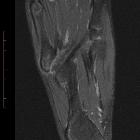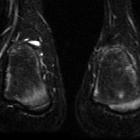Stressfrakturen der Apophysen







Apophyseal stress injury is a chronic overuse injury of the apophysis and a relatively common type of injury in young athletes.
Terminology
This entity has often been termed as apophysitis. However, as the suffix '-itis' is usually used in inflammatory-mediated conditions, it is regarded by many authors as misleading and inaccurate. Instead, they advocate the use of the term 'apophyseal stress injury' in order to emphasize the overuse etiology, or 'apophysiolysis', which indicates incomplete apophyseal fusion .
Epidemiology
Apophyseal stress injuries occur in skeletally immature patients, usually in the 2 decade of life, but they may affect younger children as well. It is postulated that the physeal closure may be delayed in the female athletes due to low estrogen levels - in such a case apophyseal injury may occur in a slightly older age group.
Clinical presentation
The patient presents with tenderness and gradual-onset chronic pain in the affected area, worsening with impact activity, and no history of trauma. A recent increase in training frequency or intensity may be reported.
Most of the injuries occur in the pelvic region, mostly due to the presence of numerous apophyses and strength of the attaching muscles. Other locations include the tibial tuberosity, inferior patellar pole, calcaneal tuberosity, 5 metatarsal base, acromion, proximal humerus, medial epicondyle and distal radius.
Pathology
Chronic traction microinjuries to the apophysis, especially in sports that require rapid muscle contractions and in gymnastics.
- injuries of the pelvic region and lower limb occur mostly in runners, soccer players and in sports that involve jumping
- injuries of the upper limb occur usually in throwers, e.g. basketball players
Radiographic features
Plain radiograph
The radiographs may be normal or show subtle apophyseal irregularities, bony remodeling or subtle physeal widening.
MRI
MRI is the most sensitive modality for detecting apophyseal stress injuries, showing:
- physeal widening without displacement
- increased signal of the physis on fluid-sensitive sequences
- bone marrow edema of the apophysis
- soft-tissue edema
Treatment and prognosis
Apophyseal stress injuries are treated conservatively with NSAIDs, activity modification and physiotherapy. The outcome is generally favorable. If not diagnosed and treated early, the injury may progress to apophyseal fragmentation or result in deformities.
See also
- acromial apophysiolysis
- medial epicondyle apophysitis
- Sinding-Larsen-Johansson disease
- Osgood-Schlatter disease
- Sever disease
- Iselin disease
Siehe auch:
und weiter:

 Assoziationen und Differentialdiagnosen zu Stressfrakturen der Apophysen:
Assoziationen und Differentialdiagnosen zu Stressfrakturen der Apophysen:
